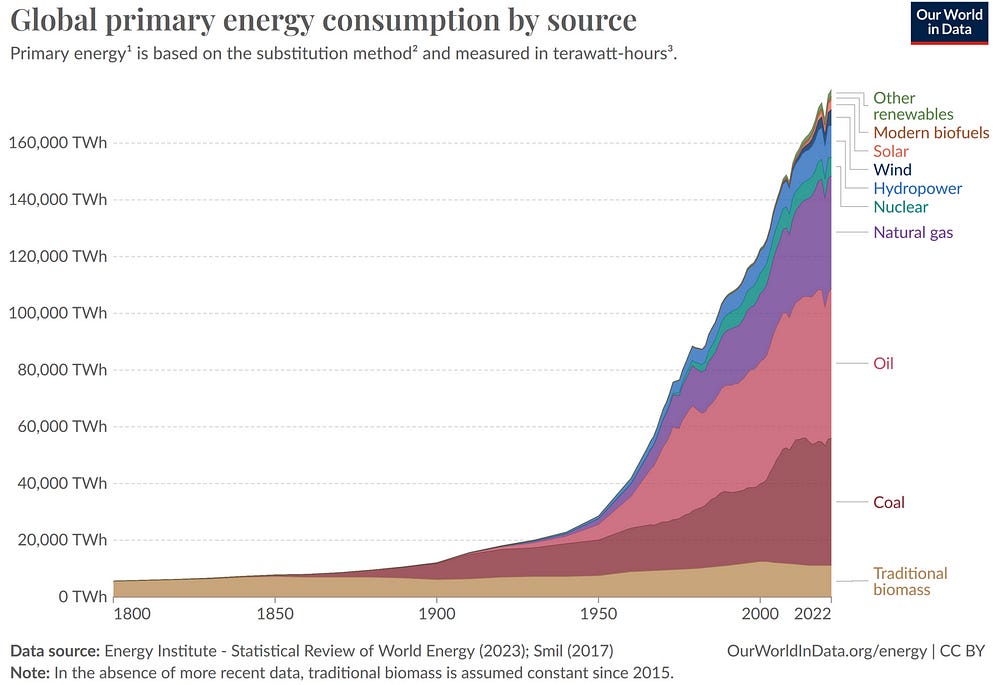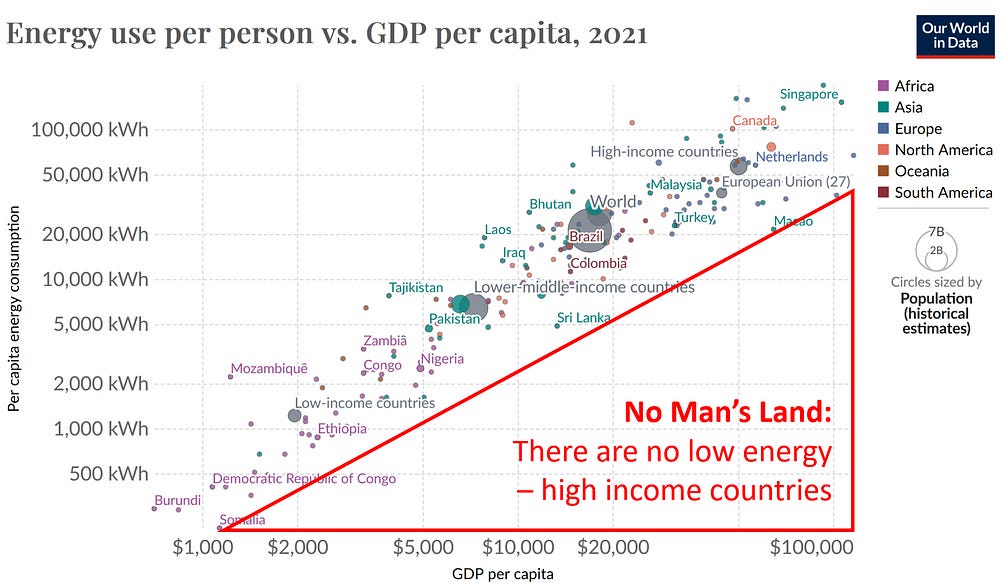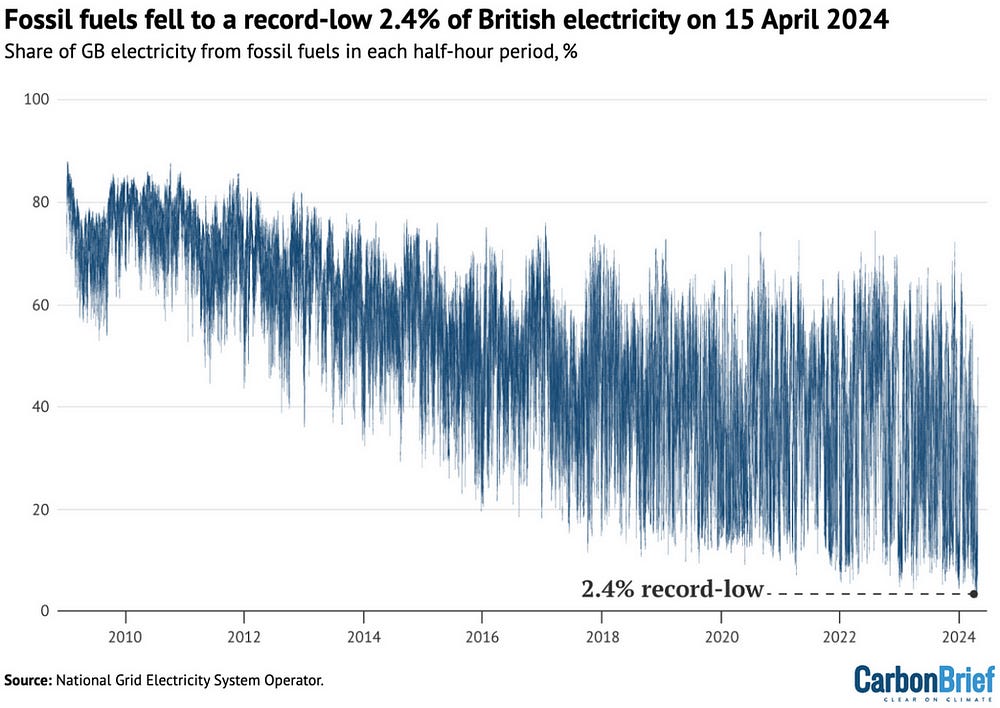The Energy Transition Story Has Become Self-Defeating
We need another kind of transformation more than ever

There is still a widespread belief that it is possible to transition away from fossil fuels, a myth which is contradicted by an ever growing body of evidence. Not that the previous model — based on coal, oil and gas — was even a slight bit more sustainable: we are talking about finite resources after all. However, the “energy transition” was a far more easier sell, than admitting that we have reached the end of growth, and that a long winding road back to a much simpler life is what awaits. Meanwhile, the real crisis (climate change), has proved to be a far more complex topic than what could be “tackled” by turning a few coal fired power plants off, and wishing for the magic unicorn of the Hydrogen economy to materialize… Where did it all go wrong? What kind of transition is possible then?
Let’s start by making a simple statement first: There has been no energy transition ever taking place in human history. Neither in the 19th century, when coal came into the picture, nor in the 20th with the advent of nuclear, or in the 21st, for that matter, with the widespread adoption of wind and solar. As the term implies, it would’ve required us to abandon a viable energy source in favour of another, ramping down the old one in advantage of the new. That would’ve meant leaving vast reserves of the old energy source out there, untapped. That has never happened, and never will, for a simple reason: the Maximum Power Principle.
The MPP posits that complex systems (like the human economy) tend to evolve in ways that maximize their power intake or energy throughput. Which means, that as long as there is a viable energy source out there, we will not stop using it: It has to run out first, or become otherwise unavailable for us. (And as the history of climate conferences show, that pretty much seems to be the case with fossil fuels.) In a nutshell: no, there is no such thing as an “energy transition” — only addition to the existing mix.

The second thing which needs to be stated here, is that energy efficiency is not a solution for two reasons. First, it too violates the Maximum Power Principle — and thus puts the entity reducing its overall energy intake into a major disadvantage; effectively allowing other entities to outcompete it. Since we are living in a competitive environment, where the weak gets eaten/occupied/robbed/colonized/etc. this cannot allowed to happen. As a result energy saved by efficiency measures will always be used up in other ways (usually by increasing economic output). And while we could debate how this is a bad thing from a moral standpoint, this is the world we live in. Just take a look at the chart below:

The other reason, why energy efficiency cannot possibly save the day (not even in a benign, cooperative environment) is the Jevons-paradox, put forward by an English economist William Stanley Jevons in 1865. The phenomenon named after him occurs when technological progress increases the efficiency with which a resource (like coal) is used, but the falling cost of use induces increases in demand. Likewise, if you were to give up coal use in favour of “renewables” all it would achieve is to make coal much cheaper elsewhere, and thereby drive up its use. The same goes for gasoline (vs electric cars) or any other form of energy saving. Unless an energy source gets physically banned worldwide, or becomes less available due to depletion, its consumption cannot be expected to fall — no matter how detrimental its use proves to be on the long run.
Now, with these two factors in mind take a look at the first chart above. Have you noticed the plateauing (or the taper off) of fossil fuels: first coal, then oil, and as of late: natural gas? Was there any ban on their use globally? No? Then why did they stopped growing? Due to the energy transition — which never was — or perhaps because of energy efficiency measures [sic]? Or maybe, because we have arrived at hard limits to their extraction? Take a minute to ponder on that.
Still, is it technically possible to do without fossil fuels, no matter why they are falling behind? “These are highly polluting forms of energy anyway, so good riddance! Just have a look at this recent headline, stating that fossil fuels fell to record-low 2.4% of British electricity generation. That’s the answer!” — Not so fast. First, take a glance at this chart from the article above:

What you see above is not the brain-wave pattern of a power grid engineer experiencing a nightmare, but something pretty close. What the graph illustrates more than a thousand words is how volatile “renewable” energy is. (Note: the chart shows half-hour periods: with 2.4% share of fossil fuels in electricity generation at say 12:30 then 75% at 13:00.) This is huge: such ups and downs means switching on and off the electricity production of an entire country in a wildly unpredictable rhythm. Widespread, unplannable random blackouts can thus only be avoided by spreading this volatility around the entire European continent AND adding a backup capable of producing up to 90% of the demand in an instant.
This is why soaring solar adoption is creating challenges for the U.S. energy grid, a claim often waved away by uttering the magic phrase: “smart grids”. While no journalist goes to great pains to explain what this actually means, as someone working in the field of electrification I can only say one thing: smart grids mean higher copper and aluminum use than you could possibly imagine. Building high voltage transformers, switchgear, inverters, converters, power lines and the list goes on — not to mention throwing a considerable amount of battery storage into the mix — all result in a massive increase in raw material use.
Now, the supply of copper — an essential metal for the “transition” — is already facing serious challenges, as older mines deplete and there are no new mining projects in the pipeline. As rich reservoirs get exhausted, however, mining companies are forced to move forward with ever lower grade ores (containing ever less copper per ton). As a result more and more rocks are needed to be shoveled and hauled for the same amount of metal, which leads to not only a significant cost increase, but growing fuel consumption as well.
Copper demand, on the other hand, from AI to electric vehicles, grid updates, batteries and “renewables” keeps soaring, and set to grow even higher. And while recycling could ease the pain somewhat, we are talking about building out a ton of new infrastructure requiring all new materials, well beyond what the recycling of old stuff could give us. (And even if we will do recycle eventually it means we would still lose 10% of the material in each round, leading to a rapid depletion of materials to be recycled only after a few cycles.)
Perhaps it goes without saying that the more “renewables” we plug into the grid, the more batteries, smart gear, high voltage cables and the rest is needed to accommodate them. This is why, as I wrote more than a year ago, that “renewables” are also prone to hit diminishing returns. Beyond a certain penetration level (and well below 100%), adding more “renewables” becomes prohibitively expensive, and eventually stops. Just take a look again at the power grid engineers nightmare chart above.
And since copper, aluminum and a range of other metals are also used by solar panels and wind turbines themselves, the whole “transition” is set to become non-financeable as the demand for these materials eventually outstrip supply and prices skyrocket. At this point taking on more debt or printing more money simply ceases to be effective: all it will achieve is a massive commodity price rally ending in a bust for the “green industry”. Is it any wonder then that grid investments are lagging behind renewable additions and a lack of transmission capacity could hold back the “energy transition” even in Europe…?
The “energy transition” on a global scale is a mirage, a lake in the desert you can never drink from.
Just to show, that I’m not talking in hypotheticals, here are some recent quotes and headlines from the media. (And again, if any of this is true, then it really doesn’t matter how much more “renewable” capacity was added last year; as further additions will become increasingly limited as demand outstrips supply, and as power grids become increasingly unable to accommodate more weather dependent sources.)
“AI Boom Could Spark a Copper Shortage”
“If you look at the demand that is coming from data centers and related to that from AI, that growth has suddenly exploded,” said Rahim. ‘‘That one million tonnes is on top of what we have as 4–5 million tonne deficit gap by 2030 anyway. That’s not something that anyone has actually factored into a lot of these supply and demand balances.”
“Copper is already tight. No one is building any new mines… It is also less expensive to acquire active copper mines, rather than to develop a new one.”
“Panama has announced the closure of a controversial copper mine after the Supreme Court ruled that a 20-year concession granted to a Canadian firm to operate it was unconstitutional.”
“Chinese smelters have been scrambling to secure raw material supplies as a result of mine disruptions, which have hamstrung its domestic supply.”
“From a long-term perspective, supply concerns remain valid. Mine disruptions and closures, combined with increasingly lower ore grades from operating mines, have already translated into plummeting treatment and refining charges. While higher copper prices will likely trigger the development of new mines, it takes an average of 16–17 years from discovery to production”
“Staying on a net-zero pathway by 2030 will require 12.8 million tons of additional copper supplies over the next five and a half years according to recent calculations from BloombergNEF. For comparison, just about 27 million tons last year. Achieving net-zero carbon emissions by 2050 will require a whopping 460% increase in copper production, which will require 194 new large-scale mines to be brought online over the next 32 years. According to the International Energy Forum report, in a business-as-usual scenario, just 35 will be added by that time. Meeting net-zero goals will therefore require a leap from the baseline never before seen in human history.”
Now add in the fact that we are still mining copper ore with diesel powered trucks and excavators, and smelt the metal using natural gas or coal... With an already soaring copper demand what is the chance of electrifying mining itself then? Such a move would cannibalize the very output they produce, leaving even less for the much vaunted “transition”. As Irina Slav explains:
“In theory, the electrification of all sorts of transportation and machinery sounds very much doable, even sometimes easy. All you need is a lot of battery packs you can replace in the piece of machinery when one drains, but you still need to use the piece of machinery.
The practice, however, is rather different. By its very definition, heavy machinery weighs quite a lot, and weight is a drain on any battery, which is why passenger EV manufacturing is a study in lightweight materials. Greater weight means faster discharge times, which in turn means more frequent battery swaps, which in turn means higher overall costs. And the transition was supposed to be cheaper than the alternative.”
I hate to be the bearer of bad news, but the “energy transition” — which never was — depends entirely on the availability of fossil fuels. And lacking an energy miracle, it will continue to do so. Building out and maintaining (load balancing) a “smart grid” requires not only copper but coal, oil and natural gas as well, even as these resources peak. Given how close we are to the maximum net energy we can get from these fuels on a global aggregate, the chances of switching away from fossil fuels grows slimmer by the day.
And we haven’t even mentioned the high costs of decarbonizing steel production or making fertilizers without fossil fuels. “Renewables” only address electricity generation — at least on paper. The main problem is, that the share of electricity in our final energy consumption is around 20%, and the remaining 80% of our energy use still comes from fossil fuels. (And as we have seen not all electricity can be generated by renewables either, so you can add a few more percentage points to that.)
People not working in the industry tend to underestimate how much high heat (above 1000 °C or 1832 °F) is required by metal smelting, cement making and other manufacturing processes (like melting and shaping glass). Not to mention the fact, that many of these processes actively make use of the carbon atoms found in fossil fuels (to make steel or to refine copper for example). So even if we could utilize all the electricity generated on this planet to make hydrogen — using a yet-to-be-invented lossless method with a 1:1 energy conversion ratio — we could only cover one quarter of the energy demand of heavy industries, mining, long distance transportation etc. needed to manufacture and ship all those shiny panels, electric cars, gadgets and the rest… And then we would be sitting in the dark, unable to charge our phones.
The true bottleneck to the world economy, and paradoxically to the “energy transition” itself, is the availability of low cost fossil fuels. As their extraction continue to require ever more energy (drilling ever deeper holes, ever more frequently, hauling up ever heavier oil at an ever higher energy cost), we will soon reach the point where we will need every other energy source just to maintain oil production, essential to everything we do as a civilization. Viewed from this perspective a soaring solar investment in the Middle East, triggered by a growing population and increasing energy demand is actually a sign of that very energy cannibalism biting us harder and harder.
And finally a few words about climate change. As industrial nations around the world clean up their air pollution from fossil fuels by scrubbing sulfur from smoke and fuels, they also decrease the amount of aerosols screening sunlight. With less aerosols, though, there are fewer low level clouds and less reflection of incoming solar radiation; directly leading to even more warming. This masking effect is also much stronger than mainstream science (IPCC) expected, inferring that there is even more warming in the pipeline than previously thought… So, how does this “energy transition” help us fighting climate change then?

The amount of hubris distilled into the bottle labelled “energy transition” is more than enough to kill a planet. Such thinking presumes limitless human control over this pale blue orb, together with its climate, resources and ecosystems. It assumes an infinite amount of minerals (copper, lithium, cobalt, silicon, aluminum etc) available for human use, while completely disregards the exponentially growing amount of energy needed to access ever poorer reserves of these rapidly depleting resources… All this coming at a similarly growing environmental cost (destruction).
It only comes as a fun fact after all this that the very energy sources needed to build out, recycle then load balance “renewables” are the ones they try to replace. Despite all the hand-waving, there are still no viable, scalable, truly renewable energy sources waiting in the wings. Everything we do from mining to agriculture, hydro to nuclear — and “solutions” like solar radiation management — remains totally dependent on the availability of dense, affordable and abundant fossil fuels.
It’s time for us to grow up and let go of our childish dreams of technology and progress saving our sorry societies. We need a psychological transition into adulthood, not a material one into oblivion.
As the massive bout of surplus energy provided by ancient carbon slowly recedes into memory, we will increasingly need to make do without this much technology. At the same time, we must also face the consequences of releasing so much carbon and other pollutants into the atmosphere, and adapt to our rapidly changing environment — or abandon places where human life is no longer possible. Instead of investing in futile attempts made at replacing the irreplaceable, or trying to put the Genie back into the bottle, we should be building out an alternative, resilient, local, low-tech, low-energy society; restoring ecosystems and figuring out a new living arrangement with the natural world as we go.
With our population also peaking and declining due to falling birth rates, will we use this slight reprieve to make such an “Ecotechnic”, truly renewable and regenerative way of life happen? Or will we double down on a green technutopia violating all the laws of thermodynamics and all what we know about how complex systems work…? Let’s face it: this unsustainable civilization is beyond repair. It needs hospicing before it’s put to rest, not another day on life support powered by green magic, and fairy tales of an “energy transition” — which never was.
Until next time,
B
Thank you for reading The Honest Sorcerer. If you would like to support my work, please subscribe for free or consider an annual subscription, perhaps leaving a tip. Every donation helps, no matter how small. Thank you in advance!






Nice article, as always.
You mention a point where renewables penetration hits the point of diminishing results.
As it happens, that point was already reached few years ago in California, but also in Spain by Easter 2022.
I wrote a series of articles detailing some problems that we will face here in Spain regarding this issue. You can find an index of the 12 entries here:
https://beamspot.substack.com/p/indice-de-lavadoras
It's written in spanish but Google translate may do a decent job. It's long, BTW, and I can send a PDF containing its 360+ pages.
Meanwhile, last week there was an "event" that almost results in a complete blackout, showing the increasing brittleness of Spain's network.
I'm currently trying to write some articles more explaining and analyzing data that show clearly that this problem was caused by a wind llull...
'Renewables' best use is small scale energy autarky. Homes, schools, small communities off-grid as much as possible, reducing national load and the possibility of hostile foreign hegemons turning off the lights in spite.
I'm of the opinion that as FF costs continue to rise, ingenuity - especially in China - will find ways to reduce the currently necessary use of those in the manufacturing and installation of future renewables, but it's hard to see a 100% 'transition'.
Of course, the true problem is the Piscean Age's vast over-population, largely caused by the mores, values and ideas of the Shit-Eating Romans, who destroyed the natural-minded Pagan societies and imposed a "Women are just cattle" mentality.
It'd be great if over-population was addressed though peaceful means - as the 'popular' alternatives tend actually to create HIGHER birth-rates to compensate, let alone being horrific in themselves - but the unreal 'Realism' of the 'developed world' will almost certainly make that impossible.
'Intelligent' species my left buttock!!